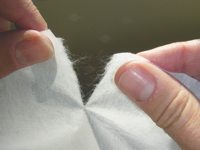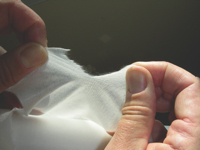Wipes are widely used in almost every type of organisation and sector for a huge array of cleaning tasks. In fact, they are so widely used that it is easy to take them for granted and to treat them as little more than a throw-away commodity.
Technicians and operators cannot do their jobs without the right tools and wipes are simply one of those tools. There are a number of different types on the market, but is one wipe the same as any other wipe?
In general, there are three broad categories of wiping products: non-woven flat wipes; woven or knitted flat wipes; and swabs. The cleaning surfaces are made from paper, cloth or synthetic materials, so which is the optimal product for a particular job?
The best place to start is by looking at absorbency of the contamination, then selecting further based on the cleanliness (lint and particulate) requirement.
Absorption usually is expressed in millilitres of water (or alcohol) absorbed by 1m2 of the material. But whereas some wipes work well with solvents or lacquers, they will not absorb water. For example, polyester is petroleum-based so polyester wipes are able to absorb gasoline, oils or grease easily. Cellulose wipes, on the other hand, are good for water-based contamination.
Cleanliness of the wipe is also crucial to the end result, and is measured in particles per square metre.
Cleanliness is inversely related to absorbency. The cleanest wipes may be less porous and unable to absorb as much, while more absorbent materials may leave fibres or residues.
Packaging also deserves some scrutiny. It should be free of particulate, with no fibres, plasticisers, silicones or ionics.
Most cleanrooms require a special ‘double-packaging’. Another feature appreciated by engineers is static-dissipative wrapping that will not attract dust.
For maximum purity, wipes and swabs must be assembled and packaged in a cleanroom; understandably, these are the most expensive. In general, fabric wipes tend to be more absorbant, stronger and durable.
They may be more expensive to buy, but they generally work out less expensive to use.
Paper wipes are found often in applications where re-contamination cannot be allowed, such as electronics and medical applications.
Flat wipes are generally made from either paper or fabric although a few companies make flat wipes from foam.
Paper (more precisely termed nonwoven) products are usually single-use disposables. Fabric wipes are woven or knitted materials using a variety of fibres.
The lowest cost nonwovens use glues (also called binders) to hold the fibres in place. Binders can be 30% of the weight of some nonwoven products.
The most common binder is a water-based latex such as polyacrylate. Most binders will dissolve when exposed to solvents, so wipes made with binders are undesirable in critical applications. They will leave adhesives, lint and fibres on the surfaces being cleaned, especially when wet.
Nonwovens
In the middle price range are nonwovens made from synthetic fibres. Polyester, polypropylene and rayon are popular choices, according to Mike Myers, Product Manager for OEM Automotive Products for Contec, of Spartanburg, SC.
‘Polyester nonwovens are ideal for pharmaceutical companies because they minimise the bioburden trapped in the wipe,’ he says. ‘But for cleaning grease and heavy oils from car parts, nothing beats textured polypropylene wipes presaturated with a d-liomene solvent.’
It is hard to believe that a paper wipe could be strong enough and clean enough to be useful in industrial situations. But paper manufacturers have developed a hybrid material called a ‘nonwoven fabric’.
This premium-priced material has the strength, softness and quality of a woven textile but is produced at the volume, speed and cost of a paper.
Woven and knitted wipes come in a range of materials, qualities and prices. The least expensive material is simply ‘reclaimed fabric’, cut from cotton shirts, jeans, old uniforms, pajamas and other materials.
A ‘mill end’ is fabric intended for clothing but which never made it to the sewing desk. These wipes will not have the seams or decoration of reclaimed fabric but may be loaded with permanent press chemicals, stain-resisters and dyes. The best grade is ‘new white washed’.
The next level is washed cheesecloth. Coming from the mill, cheesecloth is very hard and stiff, completely unsuited for wiping. However, after a thorough washing with special surfactants and detergents the material becomes very smooth and flexible.
Nearing the top of the quality pyramid is ‘washed diaper fabric’. This material is soft, strong and highly absorbent. Diaper fabric may qualify for use in Class 1000/ISO 3 cleanrooms.
Among the natural fibres, the finest quality wipes are made from cotton twill. This fabric can be processed to medical grades and even cleanroom qualified. Because of its strength, twill is often re-used, with each application progressively less critical.
If cleanroom performance is essential, opt for knitted synthetic fabrics of polyester or rayon. These materials can be extremely soft, clean and absorbent. Using a knitted product reduces linting because contamination mostly comes from the edges and ends of fibres.
The interlocking weave of the knitting process minimises loose ends and locks stray fibres into the fabric.
Some companies use a laser to slice the edges of the synthetic wipes; this melts the fibre and further minimises linting. They are washed in special double-ended cleanroom washing machines to remove any remaining lint and fibres, making these products suitable for the most demanding environments.
Swabs
Swabs are basically a wipe on a stick, and can tackle jobs an ordinary flat wipe would not handle. The key to selecting a swab is the size and shape of the head, together with the configuration of the handle.
There are round swabs, paddle-shaped flat swabs and hard-pointed conical swabs, all designed to fit the shapes people need to clean.
While absorbency is critical when selecting a swab, a unique issue is materials compatibility. The construction of the swab must be compatible with the cleaning application.
For example, if acetone is used on a foam swab, the foam tip will swell and weaken. In applications where acetone must be used, a polyester swab is the better option.
In the first decade of the 21st century, a new combination product began to achieve market penetration in critical cleaning applications: the presaturated wipe.
Although these have long been a staple in medical applications and household chores, industrial acceptance was delayed for many reasons.
Presaturated wipes are more expensive than dry wipes, and inappropriate, leaky packaging can result in a very short shelf life. Furthermore, there was the concern about worker safety and chemical handling.
Lastly, some engineers always viewed presats as an extravagance. All these factors delayed market acceptance.
But the market changed because the products improved. A presaturated wipe delivers the right fabric and the right solvent in the right combination, resulting in a more consistent cleaning performance.
There also is a time-saving enhancement because they come ready-to-use. A broader array of cleaning fluids, both water-based and solvent-based, have enabled manufacturers to tailor their presaturated wipes for different environments.
Lastly, better packaging has allowed some companies to offer presaturated products with an unlimited shelf life.
Today many companies have adopted the presaturated wipe. They can be found in stencil cleaning applications in electronics factories, hand-cleaning fluids in aircraft maintenance shops and in medical device manufacturing facilities.
Presaturated wipes require nonwoven sythetic fabrics. Natural materials will deteriorate after prolonged contact with solvents, and the glues and binders in traditional cellulose wipes will be dissolved by the solvent.
The optimal cleaning fluids for presaturated wipes are water-based with soaps, alcohols, hydrocarbons and/or siloxanes. Stronger fluids, such as d-liomine, will attack the plastic tub. Fast-drying solvents are rarely used because they will not deliver the required shelf life.
Good toxicity ratings (TLV of 200 or higher) are generally a prudent strategy.
Whatever special requirements there may be, engineers can be certain that today’s wipe manufacturers will have the answer they need.

2. Polyester nonwoven fabric ripped

3. Hydroentangled nonwoven fabric ripped
Wipes are used in virtually every industry, but the quality of the wipes and the quality of the cleaning results can vary hugely.
These three photos compare the strength of the wipes in a visual manner, emulating a more complex test of fabric strength called the ‘grab test’. When measuring paper strength, it almost always is measured across the grain of the paper.
Photo 1: Weak paper rips easily and the V between the pieces is very steep. Notice the loose fibers coming from the shredded paper. This wipe is cheap but will leave residues behind.
Photo 2: This shows a polyester wipe, and the wider V of the rip indicating a stronger paper.
Photo 3: The strongest material is the hydroentangled synthetic wipe, made without glues or binders, and the very wide V indicates it takes a great deal of pressure to shred this material. Loose fibers also are minimised with higher quality fabric. It is essential to select the right tool for the cleaning specification.
.




